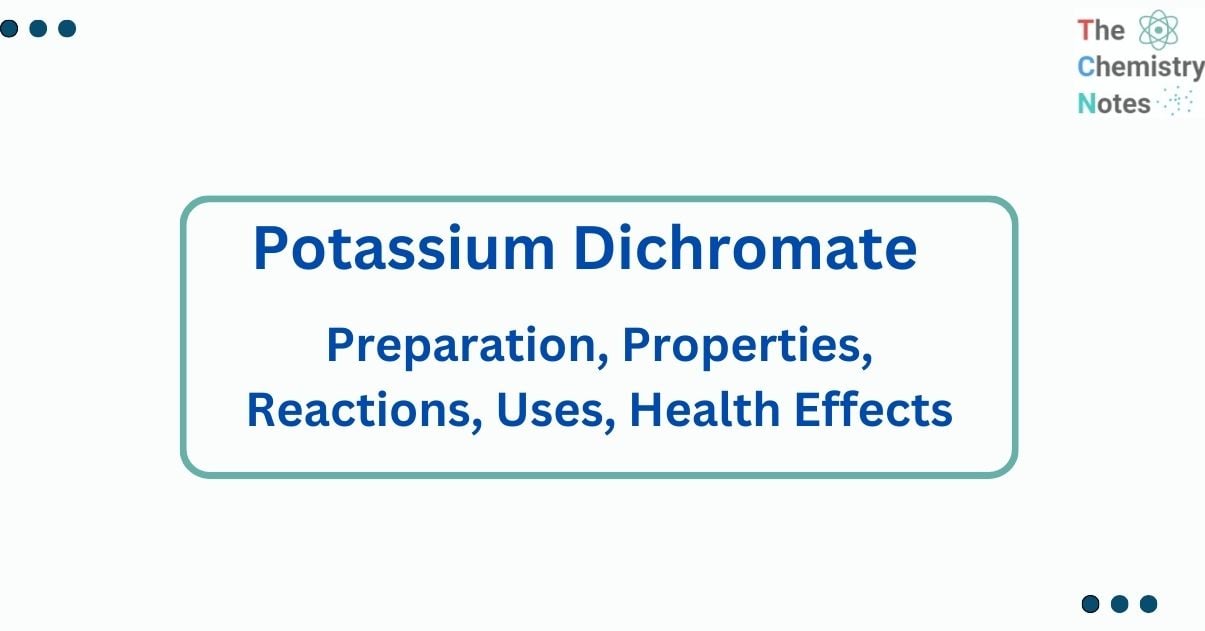
Potassium dichromate is an inorganic compound, employed as an oxidizing agent in various laboratory chemical reactions. The potassium dichromate formula contains the following elements: potassium K, chromium Cr, and oxygen O. It has the structural formula K2Cr2O7. It is composed of two potassium ions and one negatively charged dichromate ion. The chemical formula indicates that two potassium cations are interacting with a single dichromate anion.
It is a reddish-orange solid crystalline ionic. It is a strong oxidizing agent with corrosive qualities that is soluble and denser than water. Potassium dichromate can be harmful to human health if exposed for an extended period of time; consequently, it should be handled with caution. As an oxidizing agent, it has a wide range of applications in laboratories and industries.
Interesting Science Videos
Preparation of Potassium dichromate
Potassium dichromate occurs naturally in the form of lopezite, a mineral. In the manufacturing process, potassium chloride (KCl) is combined with sodium dichromate (Na2Cr2O7). Potassium chromate (K2CrO4) interacts with acids to form dichromate salts. The following is the reaction to prepare potassium dichromate.
Na2Cr2O7 + 2 KCl → K2Cr2O7 + 2 NaCl
It can also be made from potassium chromate by roasting chromite ore with potassium hydroxide. It ionizes in water as follows:
K2Cr2O7 → 2K+ + Cr2O72−
Cr2O72− + H2O ⇌ 2 CrO42- + 2 H+
Properties of Potassium Dichromate
Physical Properties
- At room temperature, it is solid and has a bright orange crystal color.
- It has no smell and has an unpleasant harsh taste.
- It is poisonous and has an unpleasant effect on the eyes.
- It rusts easily and is non-combustible.
- Potassium dichromate has a melting point of 398°C and a boiling point of 500°C. Boiling causes the decomposition of potassium dichromate.
- At high temperatures, it is highly soluble in water. Temperature influences solubility.
- It dissolves less readily in acetones than in alcohol.
- The Refractive Index is 1.738. In coordinate geometry, the chromium ion of potassium dichromate has a tetrahedral shape.
- It has a triclinic crystalline structure.
Chemical Properties
In organic chemistry, potassium dichromate exhibits oxidizing characteristics and is milder than potassium permanganate. It is employed in the oxidation of alcohol. It transforms essential alcohols to aldehyde and, under some conditions, to carboxylic acids. In contrast, carboxylic acid is a byproduct of potassium permanganate. The second alcohol is broken down into ketones.
The indicated color shift in an aqueous solution can be used to assess the separation of aldehyde and ketones. Aldehyde reduces the oxidation state of dichromate from +6 to +3, causing its color to shift from orange to green. Because the aldehyde can be oxidized to the corresponding carboxylic acid, the color changes. The ketone will not undergo such a shift because it cannot be constantly oxidized, hence the solution will remain orange.
Reactions involved
- When heated, K2Cr2O7 decomposes to form potassium chromate with the release of O2 gas.
4 K2Cr2O7 → 4 K2CrO4 + 2Cr2O3 + 3 O2
- K2Cr2O7 is a strong oxidizing agent. In the presence of dil.H2SO4, one mole of this chemical yields three oxygen atoms.
K2Cr2O7 + 4H2SO4 → K2SO4 + Cr2 (SO4)3 + 4 H2O + 3(O)
- It reacts with potassium iodide to produce I2.
K2Cr2O7 + 7 H2SO4 + 6KI → 4 K2SO4+ Cr2(SO4)3 + 3I2 + 7H2O
- Potassium dichromate oxidizes H2S into sulfur.
K2Cr2O7 + 4 H2SO4 + 3 H2S → K2SO4 + Cr2(SO4)3 + 7 H2O + 3 S
- When an orange-red solution of K2Cr2O7 combines with an alkali, a yellow solution is formed due to the creation of potassium chromate. The yellow color of K2CrO4 turns orange-red when acidified due to the reformation of K2Cr2O7.
K2Cr2O7 + 2KOH → 2 K2CrO4 + H2O
Orange-red Yellow
- K2CrO4 + H2SO4 → K2Cr2O7 + K2SO4 + H2O
Uses of Potassium dichromate
- In research institutions and industry, potassium dichromate is employed as an oxidizing agent.
- It’s used to clean glass and as an etching agent.
- It is used in the calfskin industry for chrome tanning.
- It is used in laboratories to perform volumetric tests.
- It is used in the tanning of cowhide and the preparation of potassium chrome alum.
- It’s utilized in photograph screen printing. It is used as an oxidizing agent in conjunction with solid mineral acid to harden the gelatin film.
- It is a component of cement and is thus useful in the construction sector.
- In the construction sector, K2Cr2O7 is used as a component in cement.
- It is a non-hygroscopic reagent that is employed in “wet tests” in analytical chemistry.
- When dissolved in 35% nitric acid, it is known as Schwerter’s solution and is used in tests to detect the presence of other metals in evaluating silver purity.
- It is utilized as a wood darkening agent in wood tannins, which impart a deep brown color to wood. It is an efficient mahogany treatment.
Health effects
- Chronic illnesses caused by potassium dichromate include chromium dermatitis of the hands and forearms.
- Potassium dichromate’s toxicity can damage animals such as rabbits and rats.
- It is also hazardous to aquatic organisms and poses a significant threat to the environment.
- Potassium dichromate is toxic to the respiratory system. It has the potential to cause ulcers.
- Potassium dichromate, a known human carcinogen, has been linked to an increased risk of lung cancer.
- Eating potassium dichromate can be hazardous to one’s health and can result in death.
- Consuming this drug can produce a chemical burn in the mouth and gastrointestinal tract.
- However, acute poisoning by eating or ingesting potassium dichromate is uncommon because vomiting usually occurs and renal excretion is quick.
References
- https://www.sciencedirect.com/topics/biochemistry-genetics-and-molecular-biology/potassium-dichromate
- https://www.pharmacompass.com/chemistry-chemical-name/potassium-dichromate
- https://unacademy.com/content/jee/study-material/chemistry/potassium-dichromate/
- https://study.com/academy/lesson/potassium-dichromate-definition-formula-uses.html
- https://byjus.com/jee/potassium-dichromate/
- https://www.vedantu.com/chemistry/potassium-dichromate
